Some people suggest that the latest generation gap is neurological rather then ideological. The same people are more fascinated with Mr. Pawlow’s ability to create a controlled environment than him explaining conditioned reflexes. The russian physiologist known primarily for his work on classical conditioning which not only won him the nobelprize in 1904 but influenced popular culture such as Thomas Pynchon’s ‘Gravities Rainbow’ (1973). Adam Smith, the father of modern economics, first wrote about the “invisible hand” in his unpublished book on the History of Astronomy. His aim was to give Astrology a scientific tint. It could not have occurred to him what is a pressing question for Sally Wyatt: “Why does neoclassical economics, dominated within the economics profession, continue to adhere to models of equilibrium and stasis, especially when physics itself has largely abandoned them?” Could it be that we are also linguistically still servomechanisms of our own technological ingenuity?
In the 19th century Ignaz Semmelweis discovered that the incidents of puerperal fever could be drastically cut with the use of hand disinfection in obstetrical clinics. His insight saved the lives of thousands of young mothers. By the same token, financial activists have discovered that the conscious design of monetary systems could have similar effects. Only long after his death did Mr. Semmelweis’s practice find widespread acceptance among the members of his profession. Perhaps protection against public incredulity is the best vaccine of those immune to the current economic epidemic.
The international system of currency, counter to its powers to “determine the totality of life on this planet” is a rather dull engineering subject. Like a J.F. Byrne cryptograph “it requires nothing more than a cigar box and a few bits of strings and odds and ends for its operation”. This statement is not meant to downplay the service environment built around fiat money. Anyone uploading his homemade video onto Youtube is in command of a multi-billion dollar service environment. As a fact, the whole environment becomes one’s private resource. And while “the totality of life on this planet” is indifferent to personal homemade videos it is the environment-as-private-resource that transforms culture, society and man’s sensibilities. Ask your town newspapers’ Editor in Chief or your neurologist!
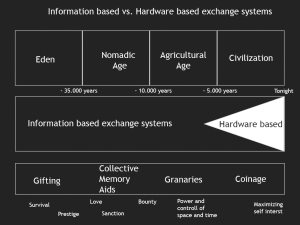
Thus, it seems natural for Prof. Bernard Lietaer to attribute the “Information Revolution” as the obvious ground in his “Future of Money”(2001). As the first popular theorist of money in the post-money and post-information age, he writes with rare clarity about his hunt for “systemic solutions” and informs the reader about his findings. He brilliantly illuminates for the popular mind the emperor’s old clothes and renders the blind spots of his adversaries tangible. Today when John Maynard Keyne’s – the challenger of neoclassical economics and founder of modern macroeconomics – ideas find feverish support, librarians face an equally a sharp rise in demand for esoteric literature. While Keynes discovered the dynamics of money as a Gutenberg medium in “Shakespeare and the Profit inflation”, Mr. Lietaer’s work rediscovered it for the Marconi Galaxy in “New Money For A New World”. With a startling surprise.
In short, what Mr. J.M. Keynes demonstrated was how to control economic processes by manipulating the monetary environment. He saw how to manage the climate of the monetary environment by managing the interest levels. Mr. Lietaer demonstrates that the reverse is also true. By conscious design of the monetary environment and its parameters we can now engineer desired economic and social processes free from ideological baggage. Was it not Niels Bohr who remarked that “the opposite of a fact is a falsehood, but the opposite of one profound truth may very well be another profound truth” ?
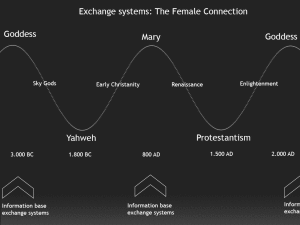 Having proceeded from his observations he concluded at the end of his first book “The ongoing money innovations are more compatible with co-operative, feminine-type interactions…. Seen from this perspective, these currency innovations fit into the general shift towards Yin priorities highlighted earlier which includes changes in the paradigms in science and medicine, politics and gender relations.” In his latest book he devotes the last two chapters elaborating on these “general shifts”. But he did not manage to break the same spell that inflicted Vico Giamattista’s work as well. Verene D.P in her book Vico’s Science of Imagination explains the dilemma; “Vicos art of reading the hieroglyphics of the sensus communus of humanity has its degenerate components in historicism and the contemporary concern with methodology in the humanities”.
Having proceeded from his observations he concluded at the end of his first book “The ongoing money innovations are more compatible with co-operative, feminine-type interactions…. Seen from this perspective, these currency innovations fit into the general shift towards Yin priorities highlighted earlier which includes changes in the paradigms in science and medicine, politics and gender relations.” In his latest book he devotes the last two chapters elaborating on these “general shifts”. But he did not manage to break the same spell that inflicted Vico Giamattista’s work as well. Verene D.P in her book Vico’s Science of Imagination explains the dilemma; “Vicos art of reading the hieroglyphics of the sensus communus of humanity has its degenerate components in historicism and the contemporary concern with methodology in the humanities”.
As a former student of classicism he would only have to align the insights of literary scholars Albert Lord and Perry Miller and fully appreciate the attempt of Leonard Shlain’s superb “Arts & Physics” to reach planetary understanding of these “general shifts”. He would have saved himself the time pointing out the “blind spots”. And might have found more comfort in his accomplishments as an Investor and Central Banker. Never the less he discovered an important connection that becomes apparent in the thoughts of Tim Jenkins outlined in his paper “What Comes After Capitalism” (2013).

Mr. Jenkin’s distinction between hardware and software exchange systems coincide with the structural differences identified by Mr. Lietaer’s Yin/Yang model (Slide 6). In Bernard’s scheme complementary currencies are lumped together as instances of the Yin archetype. Mitchell Inness sums it up quiet accurately: “Information-based exchange systems are the original type of exchange system, operating from the dawn of history before writing or numbers were invented.” What makes Bernard’s model fit the larger scheme of Mr. Jenkins is the occurrence of Yin type exchange systems since the invention of these two important cultural techniques (numbers and writings). They are widely held as the hallmark of civilization itself so much so that they are protected by UN charters.
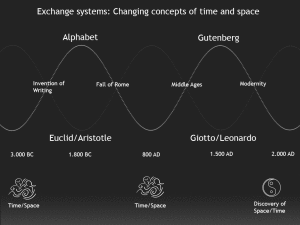
In the past 5000 years the correlation between Exchange Systems: Feminine connection (See slide 2); Exchange Systems: Changing concepts of Time and Space (See slide 7) and Exchange Systems: Complementary Currencies (See slide 4) overlap surprisingly well. When these domains are aligned one has no problem to extrapolate their contours into “The Deep History Of The Brain” (1999, Daniel Lord Snail). It also explains why Mr. Lietaer is able to observe his “structural solutions in the monetary domain” with the coming of modernity.
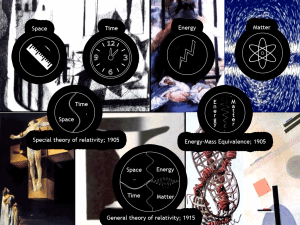
In short, his findings indicate the periods in which the Yin style exchange systems rule are those in which literacy rates are low or non-existent. Such societies are characterized by an egalitarian outlook that corporately and privately exhibit mutual trust, cooperation and sufficiency. They are found in abundance from prehistory till pre-Socratic times. Ashley Montague makes this eminently evident and seems to confirm David’s Grabners contention of the origin of violence and the Barter Myth: “The fact is that as man has advanced in civilization he has become increasingly, not less, violent and warlike. The violence’s that have been attributed to his original nature have, in fact, been acquired predominantly within the relative recent period of man’s cultural evolution. In our own time most of us have grown so accustomed to the life of each for himself that it is difficult for us to understand that for the greater part of man’s history every man of necessity lived a life of involvement in the welfare of his fellows.” Between the ascent of civilization and its descent, the only period in which literacy was vanishing in the West was between the Fall of Rome and the 13th century. Kenneth Clark states on this note that “in Europe of A.D. 800; for the preceding five centuries no layperson, from kings and emperors downward, could read or write.”
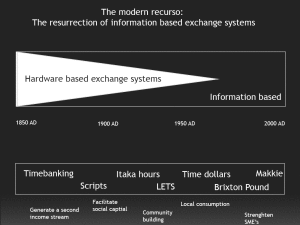
And it should not surprise us that much more than our left frontal lope got conditioned by the creation of a new service environment. In such societies, notions of nature or physics showcase time as disjointed and space as frayed and disconnected. The fact that scientific laws are subject to change in the same way as all technologies are subject to men’s innovativeness is barely accepted. Mr. Shlain only provides the starting point into this large terrain when he states “Before the rise of reason began to suppress the hegemony of mouth in classical Greece, the patron goddess of practical knowledge was Techne, from whose name we derive our word “technique,” carrying within it the idea of step-by-step scientific investigation. Yet one of the Greek words for art is techne, for she was also its goddess, and the Greek ver tikein (“to create”) is derived from her name. Techne served as the inspiration for science as well as for art.”
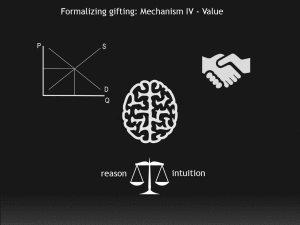
Mr. Lietaers goes further in his exploration formalizing the oldest information exchange system known as gifting. As David Grabener demonstrated again, as the backlog for gauging debt, that it was this process and not barter that predates hardware based exchange systems. Bernard intuitively posits mutual credit systems as Yin systems to explain 1. its complementary and 2. the structural differences with hardware based exchange systems; Of which fiat money is his preferred reference point. In theory it is a simple zero sum accounting system, robust and self-regulating. In practice it transforms “credit” into “reputation” in the same way as “paper promises” have been transformed into “the poor man’s credit card” at the transitory point of money from Gutenberg to Marconi. A process made explicit by McLuhan & McLuhan already in 1979.
By plotting Mr. Lietaers findings into Mr. Jenkins enlarged perspective one can learn much about the present moment then can be illustrated here. Some apologetics of monetary alternatives want to see the total abduction of the conventional monetary system. These die-hards are convinced that the financial apocalypse is near and the righteous will be admitted to a save heaven if they hold sway. They might have misread the conditions in which this apocalypse is taking shape. Since much like preliterate men who lived by the gift or “the bounty of nature”, post-literate men has yet come to terms with its modern equivalent.
The invention of Andrea Rossi and the independent confirmation of the existence of the phenomenon (LENR – low energy nuclear reaction) in 2011 paves the ground for the motivational schemes Mr. Lietear has plead guilty to call currencies almost two decades ago. As much inspiration he provided for practitioners and engineers to put the oldest wine into the latest bottles he fell short of his own ambitions. His “Future of Money” presents a rearview mirror image of a time long in the past. It seems as if providing new cures for old fears is a bad guide to inform present social actions.
By Bernd Alexander
Used works:
Bernard Lietaer; The Future of Money; 2001
Bernard Lietaer; New Money for a New World; 2012
Sally Wyatt; Rsearch paper: In danger! Metaphors at work; 2008
David Kahn; The Codebreakers; 1965
Leonard Shlain; Art & Physics – Parallel Visions in Space, Time and Light; 1991
McLuhan and Barrington Nevitt; Take Today: The Executive as Dropout; 1972
Tim Jenkins; What Comes After Capitalism; 2012
David Graeber; The First 5000 Years of Debt; 2011
Ashley Montague; The Human Revolution; 1965
Kenneth Clark; Civilisation; 1969
McLuhan & McLuhan; The Laws Of Media; 1988
Mats Lewan; An impossible invention; 2014
Description about the author:
Kapeller Bernd Alexander raised from Paternion, Austria. After graduating from the university of Salzburg and South Korea he started as producer and video journalist. Currently he works as web content coordinator in Maastricht. Founder and Lead Service Designer/Developer of the Social Exchange Platform Pendo (www.pendo.cc)


